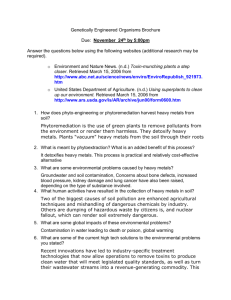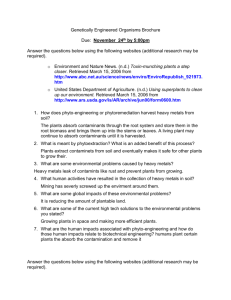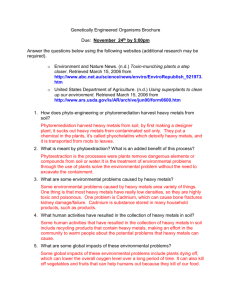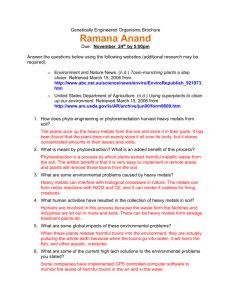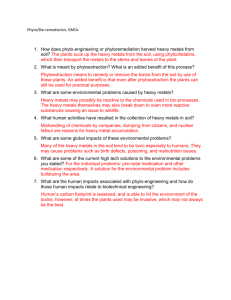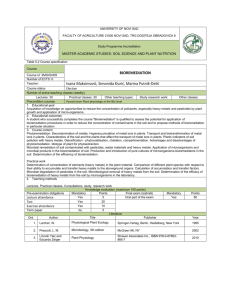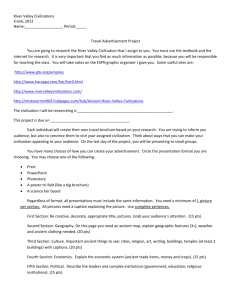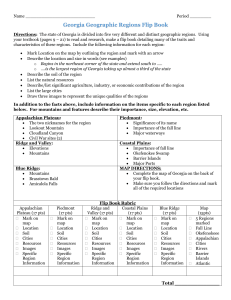File
advertisement
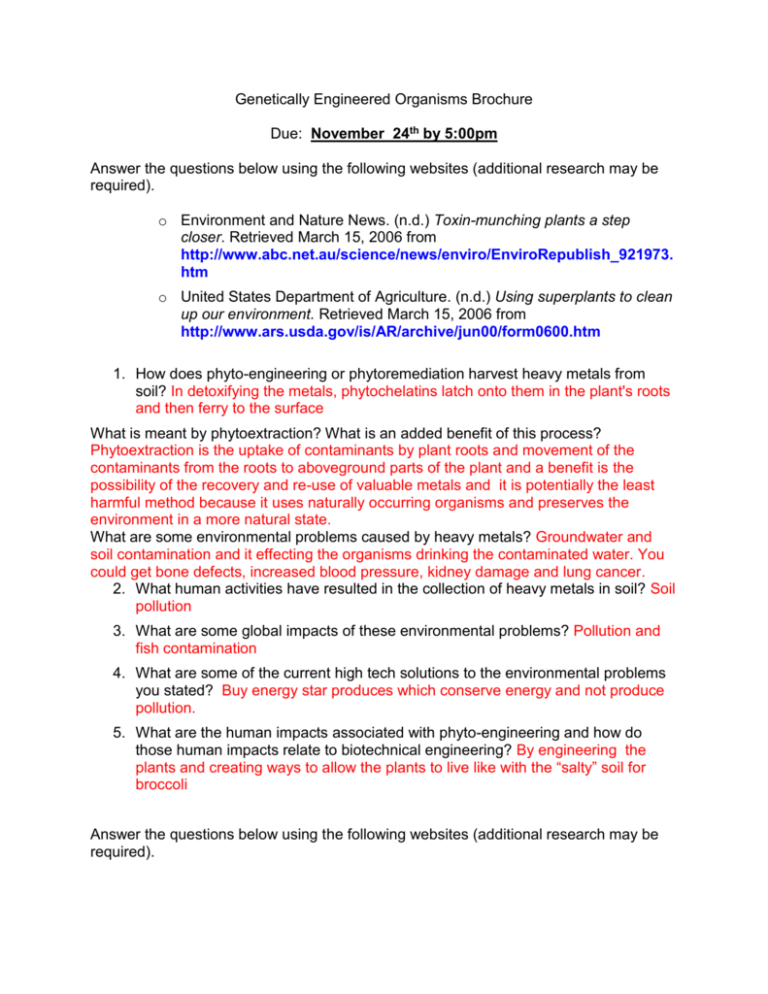
Genetically Engineered Organisms Brochure Due: November 24th by 5:00pm Answer the questions below using the following websites (additional research may be required). o Environment and Nature News. (n.d.) Toxin-munching plants a step closer. Retrieved March 15, 2006 from http://www.abc.net.au/science/news/enviro/EnviroRepublish_921973. htm o United States Department of Agriculture. (n.d.) Using superplants to clean up our environment. Retrieved March 15, 2006 from http://www.ars.usda.gov/is/AR/archive/jun00/form0600.htm 1. How does phyto-engineering or phytoremediation harvest heavy metals from soil? In detoxifying the metals, phytochelatins latch onto them in the plant's roots and then ferry to the surface What is meant by phytoextraction? What is an added benefit of this process? Phytoextraction is the uptake of contaminants by plant roots and movement of the contaminants from the roots to aboveground parts of the plant and a benefit is the possibility of the recovery and re-use of valuable metals and it is potentially the least harmful method because it uses naturally occurring organisms and preserves the environment in a more natural state. What are some environmental problems caused by heavy metals? Groundwater and soil contamination and it effecting the organisms drinking the contaminated water. You could get bone defects, increased blood pressure, kidney damage and lung cancer. 2. What human activities have resulted in the collection of heavy metals in soil? Soil pollution 3. What are some global impacts of these environmental problems? Pollution and fish contamination 4. What are some of the current high tech solutions to the environmental problems you stated? Buy energy star produces which conserve energy and not produce pollution. 5. What are the human impacts associated with phyto-engineering and how do those human impacts relate to biotechnical engineering? By engineering the plants and creating ways to allow the plants to live like with the “salty” soil for broccoli Answer the questions below using the following websites (additional research may be required). http://news.nationalgeographic.com/news/2011/04/110405-nsf-oilsomasundaran-video/ http://www.pbs.org/newshour/rundown/2010/08/study-oil-eatingmicrobes-plentiful-in-gulf-oil-spill.html 1. What is bioremediation and what role do engineers play in the process of bioremediation? Bioremediation: the use of micro-organism to metabolism and remove pollutants. Engineers role is to geneticly engineer the organism to do a certain task for them like to collect oil. 2. Explain how the following engineers work together during the bioremediation process: chemical engineers, environmental engineers, genetic engineers, and civil engineers. Chemical: able to find chemicals for the orgamisms to destroy the contaminants. Environmental: to find different ways to make the organisms safe for the environment and not create a new problem when they collect and destroy the contaminates and Genetic: to alter the organisms to adopt the genetic code and collect the “oil” and safely dispose of it. Civil: explore ways to accelerate the rates that natural bacteria degrade contaminants in soil and groundwater. 3. What impact does bioremediation play on the environment and society as a whole? Employ in areas that are inaccessible without excavation and less expensive. Answer the questions below using the following websites (additional research may be required). http://www.csa.com/discoveryguides/gmfood/overview.php http://www.ornl.gov/sci/techresources/Human_Genome/elsi/gmfood.shtml 1. What is genetically modified/engineered food? GMO is when they motifiy food to either be bigger or grow more in a surplus to feed more people in the same amount of time as natural grown food. 2. What are some potential benefits to these types of foods? We can alter the food to grow more and bigger to send to people with out food and then find different ways to put a “genetic code” ion the food like for a shot in a banana to help people. 3. What are some potential concerns to these types of foods? They are not natural and breeding and cross pollination would lead to genes in crops that insects may become resistant to and would kill the crops. 4. What are some medical ideas researchers have for these foods? To put medicine into the food so kids would have a better time “taking their shot/medicine” Using the information you have collected design a brochure to display the information to any common individual. This brochure is best created using the brochure template in Microsoft Publisher. Your brochure should include the following: _____ Information on phytoremediation (15 pts) _____ Information on bioremediation (15 pts) _____ Information on GMOs (15 pts) _____ Information on a GMO you will create (15 pts) o Get creative here and include design, potential uses, and benefits of your product _____ Pictures that help to explain your information(10 pts) _____ Creativity and aesthetics (10 pts) _____ All questions from above answered and posted on weebly (20 pts) *** This is due by 5:00pm on November 24th (that is the Sunday before we return to school).***
